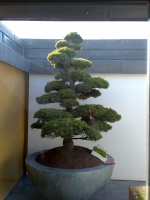River sand
+6
Brett Summers
PkWk
AK_Panama
tim stubbs
Billy M. Rhodes
kingbean
10 posters
Page 1 of 2
Page 1 of 2 • 1, 2 
 Re: River sand
Re: River sand
Usually a clean white sand with medium size particles, sometime suggested as an ingredient in bonsai soil to promote drainage, once also used as a sharp sand because it was thought the sharp edges of the sand promoted root development, now discounted as unneeded.

Billy M. Rhodes- Member
 Re: River sand
Re: River sand
As I am reading quite a lot of bonsai books at the moment the term river sand keeps cropping up and just wonderd if it was kiryu or just plain sand.
Because the japanese use river sand mixed with akadama I thought that this would fill all the gaps in the akadama thus making it not a very good mix.
Because the japanese use river sand mixed with akadama I thought that this would fill all the gaps in the akadama thus making it not a very good mix.

kingbean- Member
 Re: River sand
Re: River sand
Most of us use a more "modern" mix. Remember the Japanese use what they have/had, not because it is the only choice but because it is what they had historically. A discussion of Bonsai soil is a Pandora's Box.
I use a mix of Turface (a baked clay product), composted pine bark, and lava or pea gravel. Lava for larger trees because it makes thing lighter, pea gravel for smaller tree because the gravel is easier to get.
I also use a commercial potting mix of sand, vermiculite, composted pine bark and coir (coconut fiber) This mix is for trees that want to be/will tolerate being wetter.
Check with the other bonsai guys near you and ask what they use, since the ingredients I use may not readily available where you are.
I use a mix of Turface (a baked clay product), composted pine bark, and lava or pea gravel. Lava for larger trees because it makes thing lighter, pea gravel for smaller tree because the gravel is easier to get.
I also use a commercial potting mix of sand, vermiculite, composted pine bark and coir (coconut fiber) This mix is for trees that want to be/will tolerate being wetter.
Check with the other bonsai guys near you and ask what they use, since the ingredients I use may not readily available where you are.

Billy M. Rhodes- Member
 Re: River sand
Re: River sand
kingbean wrote:As I am reading quite a lot of bonsai books at the moment the term river sand keeps cropping up and just wonderd if it was kiryu or just plain sand.
Because the japanese use river sand mixed with akadama I thought that this would fill all the gaps in the akadama thus making it not a very good mix.
ignore what they do in japan , their climate is so different to the uk's and following their potting recipies is a waste of money for a start and as i found out next to useless in the wetter parts of the uk

tim stubbs- Member
 Re: River sand
Re: River sand
I live in the tropics and our weather is messed up. We have two seasons: hot and rainy or hot and sunny.
Many people locally mix in aboutt 30-50% black soil because it will help retain humidity and moisture during the hot summer season. The problem is, that it ends up working against you cause it grows thick, mushy, and makes it more difficult for the roots to grow. It also retains too much humidity during the rainy season and won´t drain well.
Personally, I have removed black soil from my mix entirely. In fact, I am mostly using only river sand as it:
If I need to improve moisture retention for whatever specie I am planting, I will mix some ground clay in with the river sand.
River sand is collected from river banks and is different from sea sand. Be careful in using sea sand as it has alot of salt, coral, shell, etc...
Many people locally mix in aboutt 30-50% black soil because it will help retain humidity and moisture during the hot summer season. The problem is, that it ends up working against you cause it grows thick, mushy, and makes it more difficult for the roots to grow. It also retains too much humidity during the rainy season and won´t drain well.
Personally, I have removed black soil from my mix entirely. In fact, I am mostly using only river sand as it:
- Drains well,
- Comes in various sizes (I will sieve out the bigger stones),
- Will allow the root system to "breathe,"
- Is easier for roots to grow,
- Avoids root rot,
- It retains minerals better than soil does,
- Makes it easier to transplant (the medium just falls off when yiou are removing the plant, causing less harm to the finer roots).
If I need to improve moisture retention for whatever specie I am planting, I will mix some ground clay in with the river sand.
River sand is collected from river banks and is different from sea sand. Be careful in using sea sand as it has alot of salt, coral, shell, etc...

AK_Panama- Member
 Re: River sand
Re: River sand
kingbean wrote:Can anyone tell me what river sand is please ?
River sand - sand from the river, if washed and filtered is the most ideal fine aggregate for concrete mix.
In Malaysia, river sand is never suitable for any planting because it will not only dried up in no time, got heated up fast under the hot sun and contain no nutrients.
However we have another kind of sand here - tin mining sand. Sand left over after tin mined. The tin mining business in this country had degraded vast area of land leaving the area look like semi desert. The tin mining sand is not exactly like river sand. It contain lots of fine particles and humus probably because during mining process other soil materials like top soil and dried vegetation are mixed into the sand. Luckily someone have started cultivating back the land by adding oil palm fiber and get quite a good result.
I have actually tried planting wrightia religiosa with both the type of sand. The one with river simply couldn't survive. But the other one with mining sand managed to grow on. However it's never look healthy even though I fed it more often.
I agreed with AK in about all the facts in using sand mix but not what in 6. Sand simply couldn't retain any nutrient and just drain away when you water yr bonsai or when rain.
Mixing ground clay might be an idea but clay materials will sink and condense at the bottom of the pot.
Using the appropriate soil mix is still the best way.
PkWk- Member
 Re: River sand
Re: River sand
Thank you PkWk,
You have vy valid points which I forgot to mention. Depend on where yiou collect the river sand, you will get diffent minerals and broken rock compositions. We have found one locally which is great and retains mineral very well. Regardless, we use slow release fertilizers on them.
On the grinded clay, we found a provider locally that would sell this to on order. The problem with it though, is that it comes with alot of dust and clay particles. We always have to sieve the clay to remove these, and then we run water thrgough them a couple of times to get rid of the dust. As PkWk mentioned, these miniscule particles can be very damaging otherwise.
In the end, we water our plants once or twice a day during the summer, and not at all during the rainy season (nature takes care of that part for us). Our climate is also very humid, so we have adapted to it. In the end, the only way to find out what works for you in your climate is to buy everything availabe and start mixing, documenting and ruling out. Be mindful that different species will require diffent mediums.
You have vy valid points which I forgot to mention. Depend on where yiou collect the river sand, you will get diffent minerals and broken rock compositions. We have found one locally which is great and retains mineral very well. Regardless, we use slow release fertilizers on them.
On the grinded clay, we found a provider locally that would sell this to on order. The problem with it though, is that it comes with alot of dust and clay particles. We always have to sieve the clay to remove these, and then we run water thrgough them a couple of times to get rid of the dust. As PkWk mentioned, these miniscule particles can be very damaging otherwise.
In the end, we water our plants once or twice a day during the summer, and not at all during the rainy season (nature takes care of that part for us). Our climate is also very humid, so we have adapted to it. In the end, the only way to find out what works for you in your climate is to buy everything availabe and start mixing, documenting and ruling out. Be mindful that different species will require diffent mediums.

AK_Panama- Member
 Re: River sand
Re: River sand
In the end, the only way to find out what works for you in your climate is to buy everything available and start mixing, documenting and ruling out. Be mindful that different species will require different mediums.
Although we all have to develop our soils based upon what we grow, our location, available resources, and our own cultural practices, we can earn a lot from other growers. This is one reason to join a local bonsai club. Other advantages of a local club are the education you can share with other members. Even beginners can share what worked and didn't. Also combined buying power can be great, I think it was a club in Canada that ordered a shipping container of pots from Japan, our club has a relationship with a Chinese importer as well as some great bonsai nurseries.
Although we all have to develop our soils based upon what we grow, our location, available resources, and our own cultural practices, we can earn a lot from other growers. This is one reason to join a local bonsai club. Other advantages of a local club are the education you can share with other members. Even beginners can share what worked and didn't. Also combined buying power can be great, I think it was a club in Canada that ordered a shipping container of pots from Japan, our club has a relationship with a Chinese importer as well as some great bonsai nurseries.

Billy M. Rhodes- Member
 Re: River sand
Re: River sand
Thank you Billy! I left out that valuable piece of feedback!
Another thing I just remember hearing is that you are less likely to have underground bugs, insects, plagues, etc... with river soil than you do with soil. What are your experiences with this aspect?
Another thing I just remember hearing is that you are less likely to have underground bugs, insects, plagues, etc... with river soil than you do with soil. What are your experiences with this aspect?

AK_Panama- Member
 Re: River sand
Re: River sand
AK_Panama wrote:Thank you Billy! I left out that valuable piece of feedback!
Another thing I just remember hearing is that you are less likely to have underground bugs, insects, plagues, etc. with river soil than you do with soil. What are your experiences with this aspect?
Anytime you eliminate "organic" components you will reduce soil borne insect and disease problems. The more sterile the ingredients the better. If you are forced to use regular soil from the garden/yard you should consider sterilizing it before use.

Billy M. Rhodes- Member
 Re: River sand
Re: River sand
Awesome! Never heard about sterilizing soil though. How do you go about doing this? Mixing the soil with insecticide pellets?

AK_Panama- Member
 Re: River sand
Re: River sand
AK_Panama wrote:Awesome! Never heard about sterilizing soil though. How do you go about doing this? Mixing the soil with insecticide pellets?
Not real popular with wives, but the best way is to cook it in the oven at about 160 F for a couple of hours. In Panama I think you could put the soil in a clear plastic bag and leave it in the sun for a few days, turning it over a few times.

Billy M. Rhodes- Member
 Re: River sand
Re: River sand
Lol I´m such a mess in the kitchen that I´m not even allowed to fry eggs!
I´ll spread the word though...never heard of this tactic locally.
I´ll spread the word though...never heard of this tactic locally.

AK_Panama- Member
 Re: River sand
Re: River sand
AK_Panama wrote:Lol I´m such a mess in the kitchen that I´m not even allowed to fry eggs!
I´ll spread the word though...never heard of this tactic locally.
Being banned from the kitchen is not a bad thing. My dear wife has cooked for me for 47 years.
Any soil collected from the garden, woods, etc. will be full of pathogens, bugs, etc. that can be bad for plants. That is one reason we use some many inorganic and/or non soil ingredients in our bonsai pots. Do you have access to coir, which is coconut fiber. It makes a good, renewable source of fairly sterile organic material, it is taking the place of Canadian Peat for many of us.

Billy M. Rhodes- Member
 Re: River sand
Re: River sand
Walters take on soil should be a good read for you
http://walter-pall-bonsai.blogspot.com/2010/06/feeding-substrate-and-watering-english.html
I think habit is a much more important factor than climate. I see people using everything from 100% free draining inorganic mix to a fine humic type sand in all ranges of climatic conditions. So I just don't put alot of wieght on that argument.
Ok so if a soil is too free draining for a hot climate that could be said another way as you do not want to water as often as that mix needs Although you could add some or more spag moss to the mix to fix that as well. Maybe a free draing mix needs more fertiliser than you are willing to apply. Then you should look at using a more organic mix but again this is habit.
I think a substrate is more about a complete care system rather than just climate.
http://walter-pall-bonsai.blogspot.com/2010/06/feeding-substrate-and-watering-english.html
I think habit is a much more important factor than climate. I see people using everything from 100% free draining inorganic mix to a fine humic type sand in all ranges of climatic conditions. So I just don't put alot of wieght on that argument.
Ok so if a soil is too free draining for a hot climate that could be said another way as you do not want to water as often as that mix needs Although you could add some or more spag moss to the mix to fix that as well. Maybe a free draing mix needs more fertiliser than you are willing to apply. Then you should look at using a more organic mix but again this is habit.
I think a substrate is more about a complete care system rather than just climate.
Brett Summers- Member
 Re: River sand
Re: River sand
Kingbean
What is river sand? That is one of those ambiguous terms from many bonsai books. Billy has answered you in the most sensible way. We must find growing mediums on our local levels. Instead of searching for the holy Grail of bonsai mediums.
Want to get some wierd answers ask for some definitions for
" Sandy Loame "
Best to get in touch with other locals in your area and see what they are using.
Mitch
What is river sand? That is one of those ambiguous terms from many bonsai books. Billy has answered you in the most sensible way. We must find growing mediums on our local levels. Instead of searching for the holy Grail of bonsai mediums.
Want to get some wierd answers ask for some definitions for
" Sandy Loame "
Best to get in touch with other locals in your area and see what they are using.
Mitch
Mitch Thomas- Member
 Re: River sand
Re: River sand
Kingbean, Mitch has come up with a good point: it is important not to look on river sand as some magic elixir used by venerable bonsai masters or the ancients. It is just one of many names given to common sand, and the issue is even more confused when the various terms are used indiscriminately. Over here in the UK you are unlikely to come across anything that is packaged as "river sand" outside shops who sell aquarium products - and those are at often inflated prices. Other terms you will find are builder's sand, sharp sand and coarse sand. But if you ask three builders' merchants what they mean by these terms you will get three different and contradictory answers.
If you are going to incorporate sand, you need to ask yourself the simple question "Why?" first. To be honest, I wouldn't consider using sand in my bonsai soil mixes, and I live in a very wet climate where drainage is potentially an issue. As far as I am concerned there are other, better methods of opening a soil. But, if you're sure you want to use sand, go down to your local builders' merchant or B&Q and buy it there and save yourself some money.
addendum: I am not sure how much horticultural knowledge you have so apologies if you already know this, but sand has a specific meaning in terms of soil. You won't go wrong by learning a bit about the formation of soil and as a must, look up the difference between soil texture and soil structure. HERE is but one of many links and any decent horti BTEC/HNC student textbook will give you a good basic understanding.
If you are going to incorporate sand, you need to ask yourself the simple question "Why?" first. To be honest, I wouldn't consider using sand in my bonsai soil mixes, and I live in a very wet climate where drainage is potentially an issue. As far as I am concerned there are other, better methods of opening a soil. But, if you're sure you want to use sand, go down to your local builders' merchant or B&Q and buy it there and save yourself some money.
addendum: I am not sure how much horticultural knowledge you have so apologies if you already know this, but sand has a specific meaning in terms of soil. You won't go wrong by learning a bit about the formation of soil and as a must, look up the difference between soil texture and soil structure. HERE is but one of many links and any decent horti BTEC/HNC student textbook will give you a good basic understanding.

fiona- Member
 Re: River sand
Re: River sand
While correct and interesting the link above really applies to garden soils. In a pot we can control the soil ingredients and I am not sure all of these definitions apply. I use a mix of equal parts Turface, lava, and composted pine bark or a commercial potting soil that is mostly coir with some sand and vermiculite.

Billy M. Rhodes- Member
 Re: River sand
Re: River sand
I certainly don't disagree with you Billy, but the point I'm making is that IMHO this is a case where a basic horticultural knowledge of what soil actually is can be a distinct advantage before the finer applications that you and I are familiar with in relation to bonsai soils can be made.
I'm saying this because from what I've read in this thread, I have the impression that the poster has read somewhere that river sand is something bonsai soils must have as if it were some sort of magical formula (oh lord - shades of the superthrive thread here). Rushing out and buying something because some book says so is potentially wasted effort and may actually not be conducive to plant health.
Really all I'm trying to point out to him is that there are better options for creating a decent bonsai soil than trying to hunt down an elusive substance that seldom can be found under that name in the UK, and when it is, it tends to be at inflated prices because it is marketed as a "special" soil. If he wants to use a sand, he can it much cheaper in the two places I suggested.
But it doesn't alter the fact that he needs to know why he's incorporating a sand in the first place.
I'm saying this because from what I've read in this thread, I have the impression that the poster has read somewhere that river sand is something bonsai soils must have as if it were some sort of magical formula (oh lord - shades of the superthrive thread here). Rushing out and buying something because some book says so is potentially wasted effort and may actually not be conducive to plant health.
Really all I'm trying to point out to him is that there are better options for creating a decent bonsai soil than trying to hunt down an elusive substance that seldom can be found under that name in the UK, and when it is, it tends to be at inflated prices because it is marketed as a "special" soil. If he wants to use a sand, he can it much cheaper in the two places I suggested.
But it doesn't alter the fact that he needs to know why he's incorporating a sand in the first place.

fiona- Member
 Re: River sand
Re: River sand
In this part of the world we almost exclusively use river sand as soil medium on all kind of bonsai trees.
this is my assessment as a person who used purely river sand as a medium:
The variety of river sand even here varies from places to places. some are very coarse and some are very fine, some are grayish in color some are dark to light brownish in color. This change of color and composition defines what comes with the sand and may probably affect the health of your tree in the future. Some types of sand are better for trees that you won't be needing too much fertilizer than other types. If we use river sand coming from around the city areas, chances are they have some pollutant chemicals in them and some other finer particles that is not desirable for bonsai potting use, like shereded glass particles and small bits of plastics etc. thus, the sand have to be washed and sifted. But the types coming from the rural areas specially near farm lands and mountains contains a very good composition and very rich in minerals needed by the plant. the combination of size particles are also perfect for bonsai use.
I hope this helps.
regards,
jun
P.S.
I heard from a very respectable member of IBC from Germany (the guy with so many lovely trees) in one of his interviews, that any form of medium will have the same results as long as it got a good draining quality and the tree got the fertilizer and waters it needs. I think it make sense.
this is my assessment as a person who used purely river sand as a medium:
The variety of river sand even here varies from places to places. some are very coarse and some are very fine, some are grayish in color some are dark to light brownish in color. This change of color and composition defines what comes with the sand and may probably affect the health of your tree in the future. Some types of sand are better for trees that you won't be needing too much fertilizer than other types. If we use river sand coming from around the city areas, chances are they have some pollutant chemicals in them and some other finer particles that is not desirable for bonsai potting use, like shereded glass particles and small bits of plastics etc. thus, the sand have to be washed and sifted. But the types coming from the rural areas specially near farm lands and mountains contains a very good composition and very rich in minerals needed by the plant. the combination of size particles are also perfect for bonsai use.
I hope this helps.
regards,
jun
P.S.
I heard from a very respectable member of IBC from Germany (the guy with so many lovely trees) in one of his interviews, that any form of medium will have the same results as long as it got a good draining quality and the tree got the fertilizer and waters it needs. I think it make sense.
Guest- Guest
 Re: River sand
Re: River sand
jun wrote: I heard from a very respectable member of IBC from Germany (the guy with so many lovely trees) in one of his interviews, that any form of medium will have the same results as long as it got a good draining quality and the tree got the fertilizer and waters it needs. I think it make sense.
This is what I am saying. Look this is very simple: Kingbean started this thread by asking what river sand was. The simple answer is that it is not a term used in the UK outwith the aquatic supplies shops - and in many cases they are selling ordinary sand that you'd find in B&Q (our equivalent of HomeDepot) at inflated prices just because they have given it a fancy name. I have a couple of friends with aquariums who tell me this is a matter of fact.
If he still wants to incorporate sand in his soil mix he needs to be sure that there is a horticultural reason for it and not just because he's read about this magic potion called river sand in a book - it is not a "must have" magical property of bonsai soil. Then he needs to be aware that the sand types commonly sold here are confusingly named.
I think we've answered his question. I personally found Jun's information in that last post very interesting, so perhaps a general discussion of the use of sand in bonsai soils in various parts of the world would be of value. New thread anyone?

fiona- Member
 Re: River sand
Re: River sand
I don´t understand what the sin is in kingbean asking a question he would like to obtain more information on. Is this not the correct forum for people to post these type of questions or is the thread´s title incorrect?

AK_Panama- Member
Page 1 of 2 • 1, 2 
 Similar topics
Similar topics» Ficus nebari development
» Chinese sand pear
» Purpleleaf Sand Cherry
» Garnet Beach Sand and Diamonds
» AZ ash/river birch??
» Chinese sand pear
» Purpleleaf Sand Cherry
» Garnet Beach Sand and Diamonds
» AZ ash/river birch??
Page 1 of 2
Permissions in this forum:
You cannot reply to topics in this forum|
|
|







